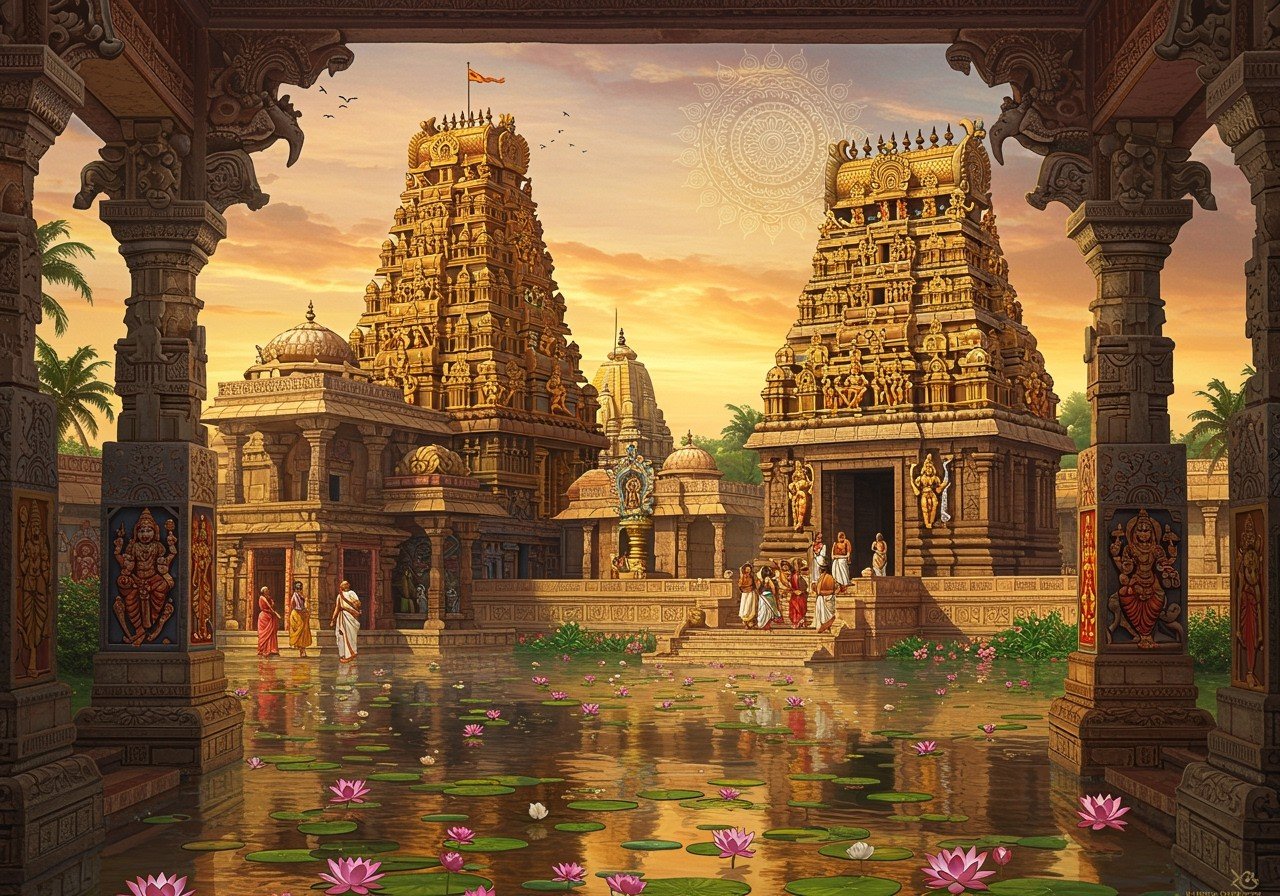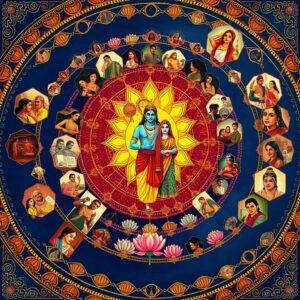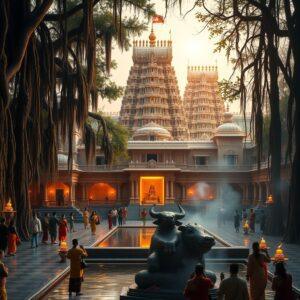
Lakshmi Narasimha temples are magnificent examples of India’s rich cultural heritage and artistic brilliance. These temples, dedicated to Narasimha, the lion-headed incarnation of Vishnu, and his consort Lakshmi, are scattered throughout India. They are renowned for their intricate designs, historical significance, and spiritual grandeur.
Historical Significance
Lakshmi Narasimha temples possess immense historical value. The worship of Narasimha stems from Hindu mythology, specifically the story of his incarnation to protect his devotee, Prahlada. The earliest temples can be traced back to the Pallava and Chola dynasties. These temples played a vital role in the Bhakti movement, which emphasized personal devotion to the deity.
Numerous dynasties, including the Vijayanagara Empire, supported the construction and renovation of these temples. References to Narasimha temples appear in ancient scriptures and epics like the Mahabharata and Puranas. These temples nurtured a sense of community and cultural identity among devotees.
Architectural Styles and Features
Lakshmi Narasimha temples showcase a variety of architectural styles. In South India, the Dravidian style is prevalent, characterized by towering gopurams (gateway towers) and elaborate carvings. North Indian temples often exhibit the Nagara style, distinguished by beehive-shaped shikharas (spires) and ornate sculptures.
Intricate stone carvings adorn these temples, depicting scenes from Hindu mythology. Key features include mandapas (pillared halls) and vimanas (towering sanctums). The layout symbolizes cosmic elements and spiritual concepts. Materials like granite, sandstone, and marble are used in construction. Notable examples include the Ahobilam temple in Andhra Pradesh and the Simhachalam temple in Odisha. You can enhance your spiritual journey with authentic puja items from poojn.in.
Iconography and Symbolism
The iconography of Lakshmi Narasimha temples is rich and symbolic. Narasimha is portrayed as a fierce lion-headed deity, embodying divine protection and justice. Various forms of Narasimha idols exist, such as Ugra Narasimha (fierce form) and Shantha Narasimha (peaceful form).
Lakshmi is frequently depicted beside Narasimha, signifying the balance between power and compassion. Temple carvings narrate mythological stories like the slaying of the demon Hiranyakashipu. Rituals and festivals reinforce the temple’s iconography and symbolism. Unique sculptures like Kirtimukha (face of glory) and Garuda (eagle mount of Vishnu) are also present. Find authentic puja items for Lakshmi Narasimha worship at poojn.in.
Regional Variations
Lakshmi Narasimha temples exhibit fascinating regional differences in architecture and worship practices. In South India, these temples often feature large water tanks called pushkarinis for ritual baths. Intricately carved monolithic pillars are a common sight, showcasing the skill of ancient artisans. Notable examples include the Yadagirigutta temple in Telangana and the Devarayana Durga temple in Karnataka.
North Indian temples, conversely, have open courtyards and vibrant frescoes. The use of colorful murals enhances the visual appeal. Local culture and traditions influence temple design and festivals, creating a unique spiritual experience. For instance, the Nuggehalli Lakshmi Narasimha Temple in Karnataka is renowned for its blend of spirituality and architectural brilliance. Explore articles on deities and rituals on poojn.in.
Temple rituals and offerings also vary based on regional customs. In some regions, offerings may include specific local delicacies or traditional items. Regional languages and literature play a crucial role in documenting the history and legends associated with these temples. This diversity enriches the cultural tapestry of Lakshmi Narasimha worship.
Renowned Temples and Their Unique Features
Several Lakshmi Narasimha temples stand out for their unique features. The Ahobilam temple complex in Andhra Pradesh is famous for its nine Narasimha shrines, each representing a different aspect of the deity.
The Simhachalam temple in Odisha is known for its ornate carvings and the annual Chandanotsavam festival. In Karnataka, the Lakshmi Narasimha temple in Hampi is renowned for its magnificent stone chariot and musical pillars. Maharashtra’s Karanja Narasimha temple has a unique idol of Narasimha holding a snake. The Singirikudi temple in Tamil Nadu is celebrated for its grand annual Brahmotsavam festival. The Lakshmi Narasimha temple in Namakkal, Tamil Nadu, offers panoramic views from its hilltop location.
Preservation and Conservation
Preserving these ancient temples is a collective responsibility. Government agencies and heritage organizations play a vital role in maintaining and restoring these structures. Modern technology and scientific methods are employed in conservation projects. Environmental factors pose significant challenges to preservation efforts. Community involvement is crucial in safeguarding these cultural treasures. Traditional craftsmen contribute by restoring intricate carvings and sculptures. Documenting historical records is essential for future generations.
Embracing Our Heritage
Lakshmi Narasimha temples are not just places of worship; they are symbols of India’s cultural diversity and artistic brilliance. Each temple offers a unique glimpse into our rich traditions. Preserving these temples honors the legacy of our ancestors. Let us take pride in our heritage and continue to celebrate these architectural wonders. You can find puja essentials for Lakshmi Narasimha and other deities at poojn.in.
Frequently Asked Questions
What is the significance of the Hampi Lakshmi Narasimha Temple? The Hampi temple is famous for its massive monolithic statue of Lord Narasimha and showcases the Vijayanagara Empire’s architectural grandeur. It is an important pilgrimage site.
What makes Nuggehalli Lakshmi Narasimha Temple unique? The Nuggehalli temple is known for its intricate Hoysala architecture, featuring detailed carvings and sculptures that depict various mythological stories.
How old are these temples? The Hampi temple dates back to the early 16th century, while the Nuggehalli temple was built in the 13th century.
Are there other architecturally significant Lakshmi Narasimha Temples in India? Yes, several others exist, each with unique architectural styles and historical importance, like the Ahobilam and Yadagirigutta Temples. Learn more about temples and rituals on poojn.in.
Can you visit these temples throughout the year? Yes, but the best time is during the cooler months (October-March).
What architectural features should I look for? Look for intricate carvings, grand pillars, detailed sculptures, and unique elements like vimanas and mandapas, often in Dravidian or Hoysala styles.
Are there any festivals celebrated at these temples? Yes, including Narasimha Jayanti, annual temple fairs, and special poojas. Poojn.in offers a wide selection of puja items for these occasions: poojn.in.
Is there an entry fee? Most temples do not charge an entry fee, but some may have a nominal fee for special darshans or poojas.


